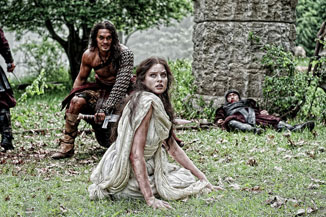|
|
Book vs. MovieConan the BarbarianBy Russ BickerstaffAugust 24, 2011
The theme in question comes from a variation on a quote by Nietzsche from Twilight of the Idols. “What doesn’t kill you makes you stronger.” Milius spends much of the rest of the film illustrating that idea with a loose interpretation of the character of Conan. His family is killed and he becomes first a slave, then a gladiator. The whole Spartacus thing was already well played-out in cinema by the time Conan hit the screen, so much of the early part of the film feels very, very weak. Milius saw to it that there would be very, very little dialogue in the film, which plays out in places like cheap, poorly executed cinematic opera. The battle scenes are executed like home movies - there’s no epic scale to the action. Bakshi’s Lord of the Rings (1978) had much more intensity to the visual poetry of its battle scenes than what we see here. Of course, with less dialogue, the character of Conan has less to define him beyond his basic physicality. And while it’s difficult to imagine Schwarzenegger managing to be much more than a leathery prop in the film, a bit more dialogue would have backed-up the personality of the character a little bit. As the film rounds out its first half hour, we see him becoming a successful slave gladiator before being trained in far eastern arts and (for some reason) taught from ancient texts. (Okay, learning multiple languages as a rugged traveler is one thing, but why bother having a gladiator learn from texts of numerous languages?)
[ View other Book vs. Movie columns ]
[ View other columns by Russ Bickerstaff ]
[ Email this column ]
|

|
|
|

|
Friday, November 1, 2024
© 2024 Box Office Prophets, a division of One Of Us, Inc.


